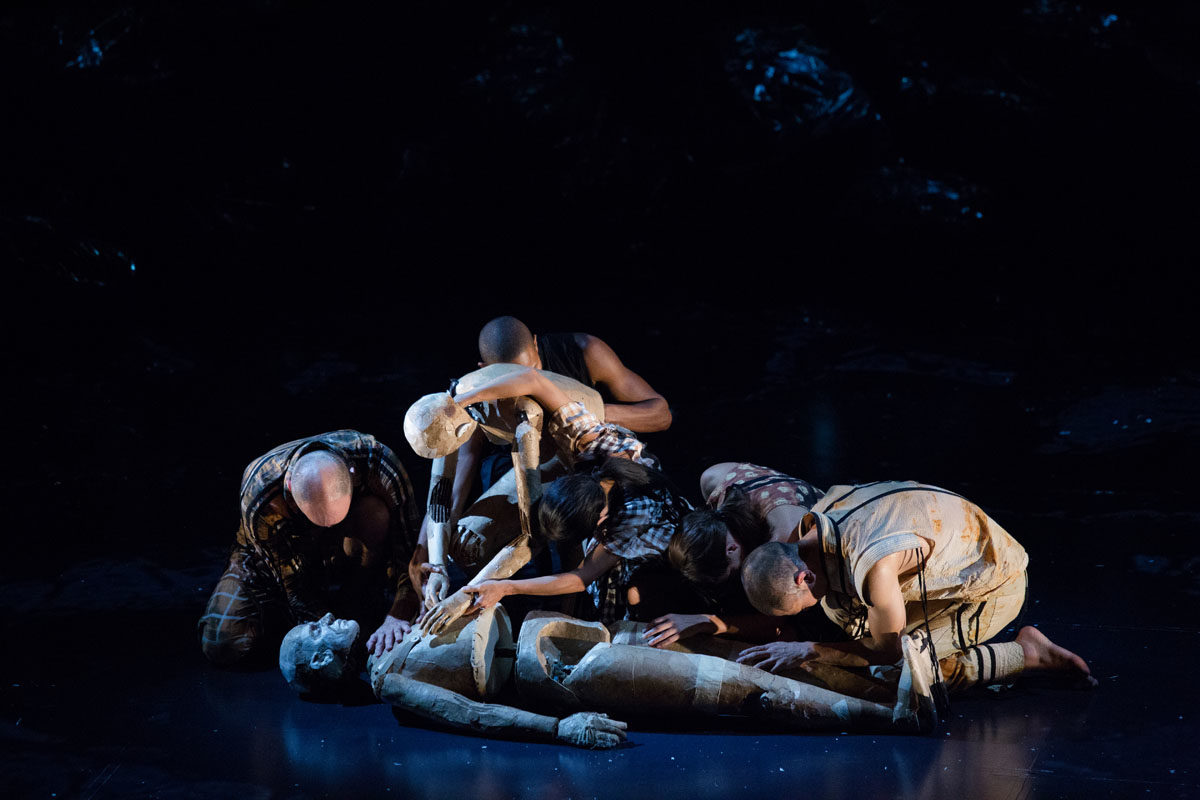
Inspired by Phantom Limb Company's Falling Out
Inspired by Phantom Limb Company's Falling Out
In response to Falling Out.
Islands //
The puppets are rough-hewn pieces of human parts—limbs, a torso, and a head. One body floats slowly on its back across the stage, as if on the surface of water, held aloft by five or six dancers crawling slowly underneath. While the mannequin lies prone above them, conceivably dead, there is still somehow a pronounced sense of animation—of humanity. One dancer stops, curled on the floor while the mass of arms and hands continue on past our sight. Life falling away bit by bit, like an island slowly falling into the sea.
This is Falling Out, the third installment in a trilogy by Phantom Limb Company. Each piece of the trilogy explores an element of the environment and its relationship to humankind: ice, trees, and finally, water. As the water piece, Falling Out unfolds various narratives around the earthquake, tsunami, and subsequent nuclear meltdown in Fukushima, Japan in March of 2011. Phantom Limb uses seemingly disparate forms--Puppetry, Butoh, and Flex--yet they are closely intertwined,collectively encountering an event of grief and loss that is both specific and universal.
***
Figures enveloped in large tan overcoats walk as if on coals—tenderly and with deliberation. Small round circles of black shades cover their eyes. A recording reverberates across the stage…someone describing which foods are now safe to eat, and which are toxic. The peaches, you can eat peaches… As the figures cup their hands and eat invisible fruit, the question hangs in the air—Is it poisonous? Throughout the narrative, these figures vacillate between emotional removal and quaking agony, both enactments of the body’s responses to unimaginable trauma. These figures dance the “dance of darkness”--a rough translation of the name Ankoku Butoh.
Butoh Master Kai Matsuoka describes Butoh form and its dancers as “focusing mainly on the theme of death…they deal with the human body as material.”[1] At its birth, Butoh was explicitly counter to many dominant expectations of art. It was dark. Volatile. Sexual. It asked of the world, is it poisonous? and then sank its teeth in. In its calculated strangeness, Butoh sought to create a language of pain, a language of its own, apart from traditional Japanese art and the powerful wave of the Western world.
***
A twisted mass of white, ghostly fabric bubbles up from a black wall of plastic bags. Wrapped in its ominous presence is a dancer, who moves with aquatic grace. Soon, however, a distant thunder grows louder, white foam spills out, and the dancer begins to shake and jerk in physical distress. Wrapped in a white shroud, the figure bleeds the lines between the inflicted and the inflictor. He seizes and writhes in increased intensity. Is he the victim, or the source?
Victim or inflictor...fluidity or percussiveness...power or weakness. These dualities are a dance within a dance, a form born in Brooklyn and commonly known as Flex. Within Falling Out it is, as principal flex dancer Klassic describes, a dance that moves in the abstract realms, and a form that is heavily character-based. To Flex is to move from reaction to becoming. Do you hear the thunder? Do you see the shroud? It wraps itself around you. It is you.
Vessels //
A large screen plays a series of interviews from individuals affected by the tsunami and nuclear meltdown in Fukushima, while dancers imitate the gestures of the interviewees. A waving of the arm. There were a few people who made it to that roof. An indication to the throat. The children—they all got cancer. Hands writing with an imaginary pen. I put it all in my writing. As the dancers adopt these series of movements, one by one they turn around to face the audience, transforming imitation into layers of gestural rounds.
Puppet master Erik Sanko thinks of the puppet as “a blank canvas…as an empty vessel that the viewer projects onto or into…in terms of Butoh, they refer to the body physically as a vessel.” The vignette of learning gestures near the top of the show hint that Falling Out is less a performance of explanation, and more a practice of what the company co-founder Jessica Grindstaff calls “physical empathy.”
“When I told people I was going to Japan for this project, I was told by a lot of people ‘you should do your research,’ ‘be careful to do your research…’ I just said, I’m going there to listen.”
This is what Falling Out is helping us learn. The slowest walk across the stage—Listen. Human-like puppets made of chiseled wood, moving as if underwater toward each other—Empty yourself so you can be filled. A figure drowning in ghostly fabric, shaking wildly in pain.—Can you fill yourself up another person’s pain?
Bodies //
The bags, black, plastic, numbered in white streaks, pile in distended forms. Throughout the performance it is a wall keeping the water at bay, then a churning river and an embodiment of how locals described seeing the tsunami’s first foray: a massive black wall. The wall moves slowly forward, spilling over itself limply. Dead and yet taking life with it.
How do we contain something that has already overpowered us?
At one point, one of the bags is opened, and body parts of a mannequin-puppet are drawn out. These parts float and circle in imagined water. At times they assemble, whole and animate, only to fly apart again as a loved one, blindfolded, reaches out desperately. An echoed song plays in the undulating light: but I only have eyes for you…
What do we do with our love when the bodies of those we poured into are gone?
The black bags are echoes of the hundreds of thousands of waste bags containing the soil around Fukushima. Cut from the top meters of the contaminated area, this poisoned earth still takes up miles of land. The dancers move the pile of bags from one side of the space to another with an air of industry—then they move them to the other side again, then along the wall, then in one pile in the center…They shift and reorganize the bags, growing desperate, even panicked.
How do we bury our disasters without burying ourselves with them?
“The puppets have actually come to represent the people that were lost in the disaster,” Grindstaff says. “…The puppeteers are always trying to re-conjure their memory, so in that way, they have become this sort of symbol of memory, or this husk of a collective loss.”[2] With loss, with unimaginable tragedy, humankind is often left to ask questions with no answers. How do we contain…? What do we do…? How do we bury…?
Falling Out is not answering these questions, but it is trying to teach us to empty our bodies, and to be filled with the asking itself.
[1] YouTube Video-Making Falling Out: BAM 2018 Next Wave Festival. Accessed 10.21.18
[2] YouTube Video-Making Falling Out: BAM 2018 Next Wave Festival. Accessed 10.21.18


